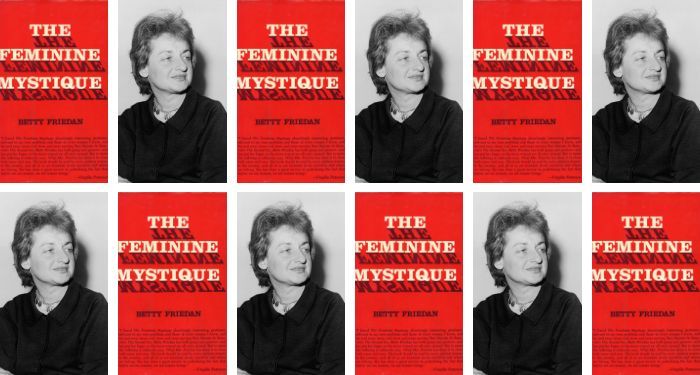
Was Betty Friedan the Originator of “Gaslight Gatekeep Girlboss”?
If you are a woman or gay man on the Internet in the year of our lord 2024, you have most likely, at one time or another, come across the 21st-century slang term “Gaslight gatekeep girlboss.” It’s a phrase of words put together to mimic the simplicity of such signage like “live laugh love,” a sentiment often thought to be enjoyed by people who have benefitted from white privilege. In other words, being able to “live laugh love” is easier when you’re a white person.
“Gaslight gatekeep girlboss” is intended in the same vein, whereby the rise of the term “girlboss” in the 2010s led young women entering the workforce to believe that they had just as much power and control as their male counterparts, yet another modern attempt at “solving” feminism. But as anybody who has ever paid attention to feminist thought or theory can attest, there is no one solution to feminism. And in the case of the “girlboss” label or identifier, it is rather another attempt from the patriarchy to gaslight and gatekeep the goals, dreams, and accomplishments of women. Thus, the phrase.
“The girlboss is one of the cruelest tricks capitalism ever perpetrated,” wrote Alex Abad-Santos for Vox. “Born in the mid-2010s, she was simultaneously a power fantasy and a utopian promise. As a female business leader — be she a CEO, an aspiring CEO, or an independent MLM superseller — the girlboss was going to unapologetically will empires from the rubble of rejection and underestimation she faced all her life. As companies grew in her image, so did her mythos; her legacy would be grand and fair, because equality was coming to work. Everyone was supposed to win when girlbosses won. Hard work would finally pay off.”
But alas, it was just another bid to distract mainstream mass media from the challenges feminism still faces, the challenges that the fight for equality in general still faces. According to Alexandra Solomon, a professor of gender and gender roles, the “girlboss” inherently has internalized sexism attached to it. “Research shows that as women get older, and as women become more powerful, they are perceived as less likable. So by using that term girlboss, there’s a desire to be powerful but a fear of losing likability.” Per Abad-Santos, the verb “to girlboss” became akin to the verbs of “gaslight” and “gatekeep” on social media like Twitter and TikTok, thus the slang.
All of this evidence withstanding, I’ve often thought about how “gaslight gatekeep girlboss” extends beyond just the working woman in the 21st century who has to have “girl” added to her job title so men won’t be too scared of her. I’ve thought about girlbosses from centuries and decades past who needed to adhere to certain standards of gender and sexuality in order to be taken seriously by the patriarchy with her threats. In this sense, to gaslight, gatekeep, and girlboss can be three things a woman must do not only to herself to succeed in a man’s world but to other women around her.
Take Betty Friedan. Lauded as the mother of second-wave feminism in the United States with the publication of her landmark book The Feminine Mystique in 1963, she would help found the National Organization for Women (NOW) in 1966 and organize the Women’s Strike for Equality in 1970. Naturally, feminism has changed and progressed, mostly for the better, since the generations of our grandmothers. But that doesn’t excuse some of the behavior of women like Friedan during their respective heydays, who virtually had to step on other women on her way to the top.
It isn’t a secret in feminist studies that, in the 1960s and ‘70s, Friedan was homophobic. According to her 2001 memoir Life So Far, she alleged that she only knew of one gay man while she was growing up in early 20th-century Illinois and that the “whole idea of homosexuality made [her] profoundly uneasy.” OK, not exactly scandalous since mindsets like that were, unfortunately, the norm at that time. As she got older and feminism progressed, she admitted to having been “square” about the notion of homosexuality in previous decades, suggesting that she wasn’t as homophobic in later life. But that doesn’t justify her conduct and attitude towards lesbian women in the early days of NOW.
Friedan essentially didn’t believe, at least not in the 1960s and ‘70s, that feminism was intersectional. She believed that the plight of lesbian women was separate from those of her group, so to speak, who were fighting for the (white) heterosexual woman’s right to be freed from the kitchen. Friedan’s attitude towards lesbians who did manage to join NOW at that time was often avoidant or hostile. So it should come as no surprise that with a leader who behaved in such a way towards another minority, a subgroup of people from NOW joined to form what would become known as the Lavender Menace.
The Lavender Menace was a group of lesbian radical feminists who came together to protest the exclusion of both feminists and their issues from the feminist movement. It was actually Friedan who gave them their name, reminiscent of the Lavender Scare from the 1950s in which homosexuals were hunted and fired from their U.S. government jobs. (The color lavender is also just associated with the LGBTQ+ rights movement in general.)
“Many feminists, not just Friedan, in the National Organization for Women (NOW) felt that lesbian issues were irrelevant to the majority of women and would hinder the feminist cause, and that identifying the movement with lesbians and their rights would make it harder to win feminist victories,” wrote Linda Napikoski for ThoughtCo. “Many lesbians had found a comfortable activism home within the rising feminist movement, and this exclusion stung. It called into serious question for them the concept of ‘sisterhood.’ If ‘the personal is political,’ how could sexual identity, women identifying with women and not with men, not be part of feminism?”
Friedan did face criticism from fellow feminists for the controversy that led to the forming of what would become the Lavender Menace, as well as her comments and worries that the group would hinder the overall fight for women’s equality. As such, author Rita Mae Brown infamously quit her administrative job for NOW in February 1970, having had enough of Friedan’s anti-lesbian and homophobic rhetoric. By 1971, with Friedan no longer in charge, NOW began including lesbian rights and issues in their policies, and they would later become one of the central issues that NOW concerns themselves with today.
At the National Women’s Conference in Houston, Texas, in 1977, Friedan apologized for promoting the exclusion of lesbians and for referring to them as “disrupters” during her tenure at NOW, and supported bills that would ban sexual preference discrimination. But sadly, the damage was done, and many lesbian women felt ostracized from second-wave feminism, needing to take matters into their own hands rather than have the mainstream feminist movement address them as women.
If we think of Friedan as a type of girlboss in her day, one who had shattered the proverbial glass ceiling with The Feminine Mystique, who finally gave words to “the problem that has no name,” she needed to do everything in her power to be taken seriously by patriarchal mass culture. Whether it was a political tactic or merely influenced by her own homophobic prejudices, her decision to exclude lesbians from the second-wave feminist movement was deliberate. While we certainly don’t remember feminism’s second wave for being intersectional, it’s almost as if Friedan could have backed up her choices by saying, “It’s not personal, it’s business,” the way any man would flippantly do.
While Friedan’s contributions to second-wave feminism were immense and influential, she, too, was a victim of patriarchy, first for keeping her in the kitchen and then for fooling her into believing that any fight for women’s equality could exclude any type of woman who doesn’t adhere to certain standards. Ultimately, Friedan’s own internalized misogyny that went unresolved during that era was the thing that hindered the feminist movement, not the Lavender Menace. She, too, was gaslit and gatekept into believing she was a girlboss, and she spread that toxicity around.
It often feels like an impossible uphill battle when the needle for advances in feminism keeps getting moved by the still-standing patriarchy. But any warrior worth their salt knows that the only way to be useful to their cause is to fight their own battles first. If I may paraphrase RuPaul, “If you can’t fight yo’ own battles, how in the hell you gon’ fight everyone else’s?”










